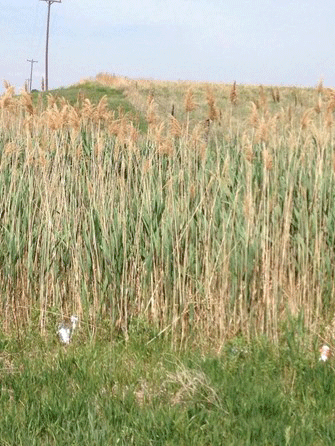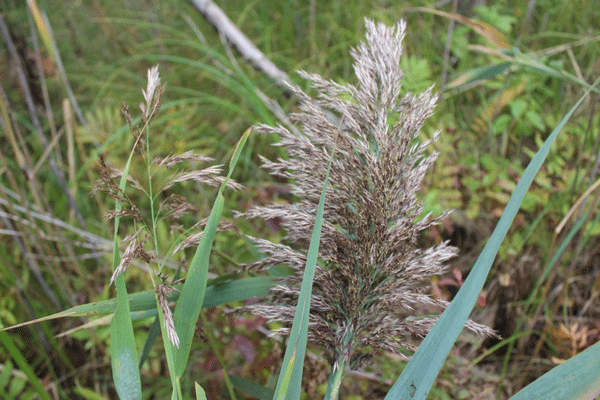Late summer is an excellent time for herbicide applications to control Phragmites, or common reed, which is a perennial plant that is increasing in Kansas waterways, wetlands, and roadsides.

Figure 1. Dense stand of non-native Phragmites at the Kanopolis Recreation Area. Photo by Robert Buhler, Kansas Department of Agriculture.
There are actually two subspecies of Phragmites in Kansas: a non-invasive native species and an introduced species that is considered a noxious weed in Nebraska and Colorado, but not in Kansas. Some key characteristics that distinguish the non-native species are:
- Dense, monoculture stands with many standing dead stems. (Native stands have more plant diversity and fewer dead stems.)
- Rough, green stems. (Native stems are smooth, glossy, and rose/red in the lower part of the plant.)
- Leaf retention after senescence. (Native leaves are easily removed and often dropped from stems.)

Figure 2. Phragmites seed heads: native (left) and non-native (right). Photo from Great Lakes Phragmites Collaborative.
If you have identified non-native Phragmites in your area, you can report the location to EDD MapS (Early Detection and Distribution Mapping System).
Management options
We currently lack data from Kansas regarding Phragmites control, but recommendations from the Great Lakes Phragmites Collaborative include nonchemical options such as:
- Mechanical removal to allow better site access for herbicide applications. This can be done with large or small equipment, depending on the size of the stand. Removal is most beneficial before seed heads are produced and is often done before plants break dormancy in the spring.
- Prescribed fire to increase the effectiveness of future herbicide treatments. This is most effective during the winter when the plants are dormant.
- Cutting stems so the entire plant is below the waterline to ‘drown’ the plants. This can be effective when done during phases of active growth in spring/early summer, or once the plant begins to translocate carbohydrates to the rhizomes in late summer/fall. Cut plants should be removed from the site.
- Manual removal below the soil surface. This requires the removal of the shoots below ground. Cutting the stems above the soil surface may stimulate growth.
Herbicides are generally the most effective means of controlling Phragmites. The best time for application is after the plant stops using energy to produce seeds and begins to prepare to overwinter by translocating carbohydrates to the rhizomes (summer/fall).
Because Phragmites is a perennial plant, multiple applications will likely be needed to completely kill the rhizomes, especially in large, well-established stands. Herbicide and surfactant options are often limited due to the need for an aquatic application label. The two products most commonly used are glyphosate (Rodeo, others) and imazapyr (Arsenal, others). Suggested rates and other information are provided in Table 1.
Table 1. Suggested rates and timing for commonly used herbicides to control Phragmites.
|
Chemical name |
Trade name |
Best timing |
Rate (aerial application) |
Rate (low-volume backpack application) |
|
Glyphosate |
Rodeo |
After full bloom and before first killing frost |
4 to 6 pints per acre + NIS |
0.75 to 2% solution + NIS |
|
Imazapyr |
Arsenal |
After full leaf elongation and before first killing frost |
4 to 6 pints per acre + NIS |
1 to 1.5% solution + NIS |
|
Glyphosate + Imazapyr |
-- |
After full bloom and before first killing frost |
3 pints + 3 pints + NIS |
0.75% + 0.75% solution + NIS |
|
Imazamox |
Clearcast |
After full leaf elongation and before first killing frost |
4 pints per acre + NIS |
1 to 2% solution + NIS |
Aquatic applications often lend themselves to aerial applications, typically by helicopter or drone, provided the herbicide label allows for aerial application. When applying glyphosate or imazapyr for control of Phragmites, care should be taken to avoid off-target movement and injury to desired species and follow the setback distance to water intakes.
The use of trade names is for clarity to readers and does not imply endorsement of a particular product, nor does exclusion imply non-approval. Always consult the herbicide label for the most current use requirements.
Sarah Lancaster, Weed Science Extension Specialist
slancaster@ksu.edu
Jeremie Kouame, Weed Scientist – Agricultural Research Center, Hays
jkouame@ksu.edu
Deepak Joshi, Precision Ag Extension Specialist
drjoshi@ksu.edu